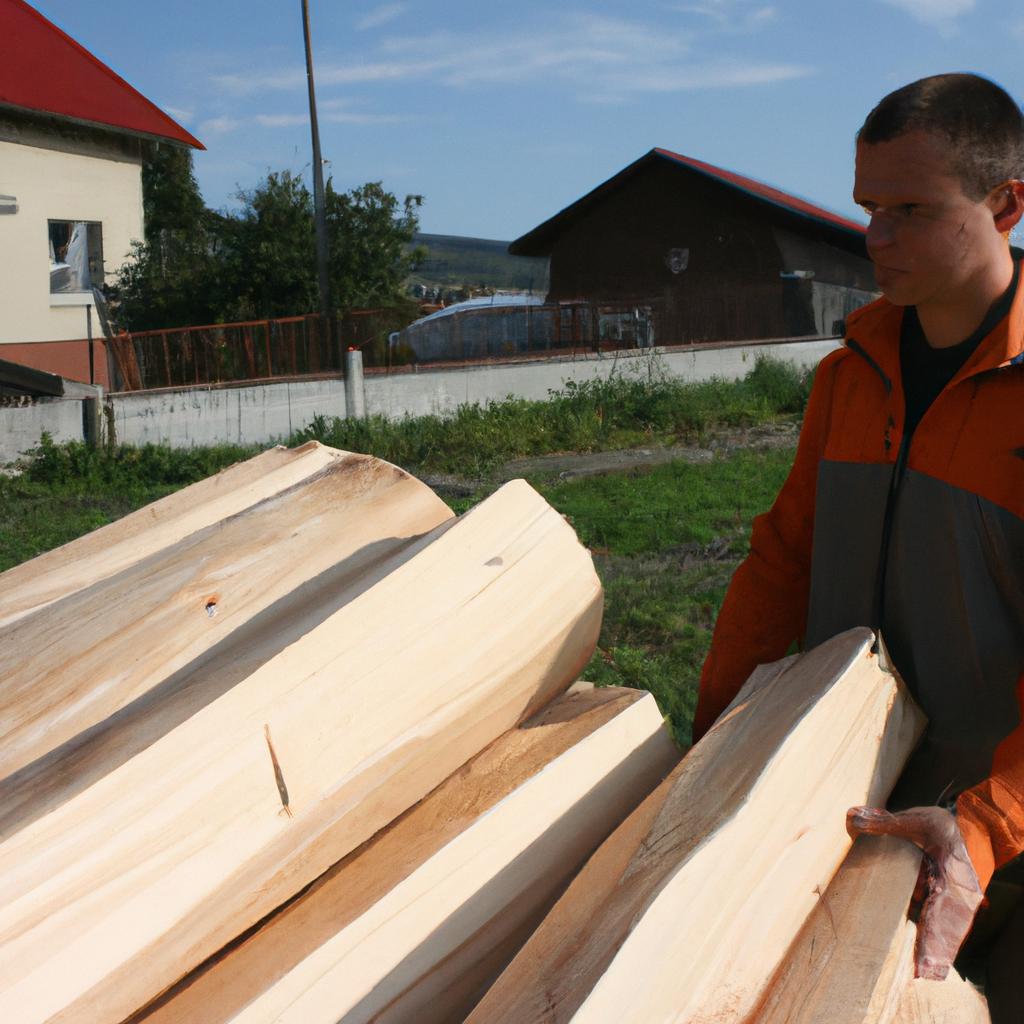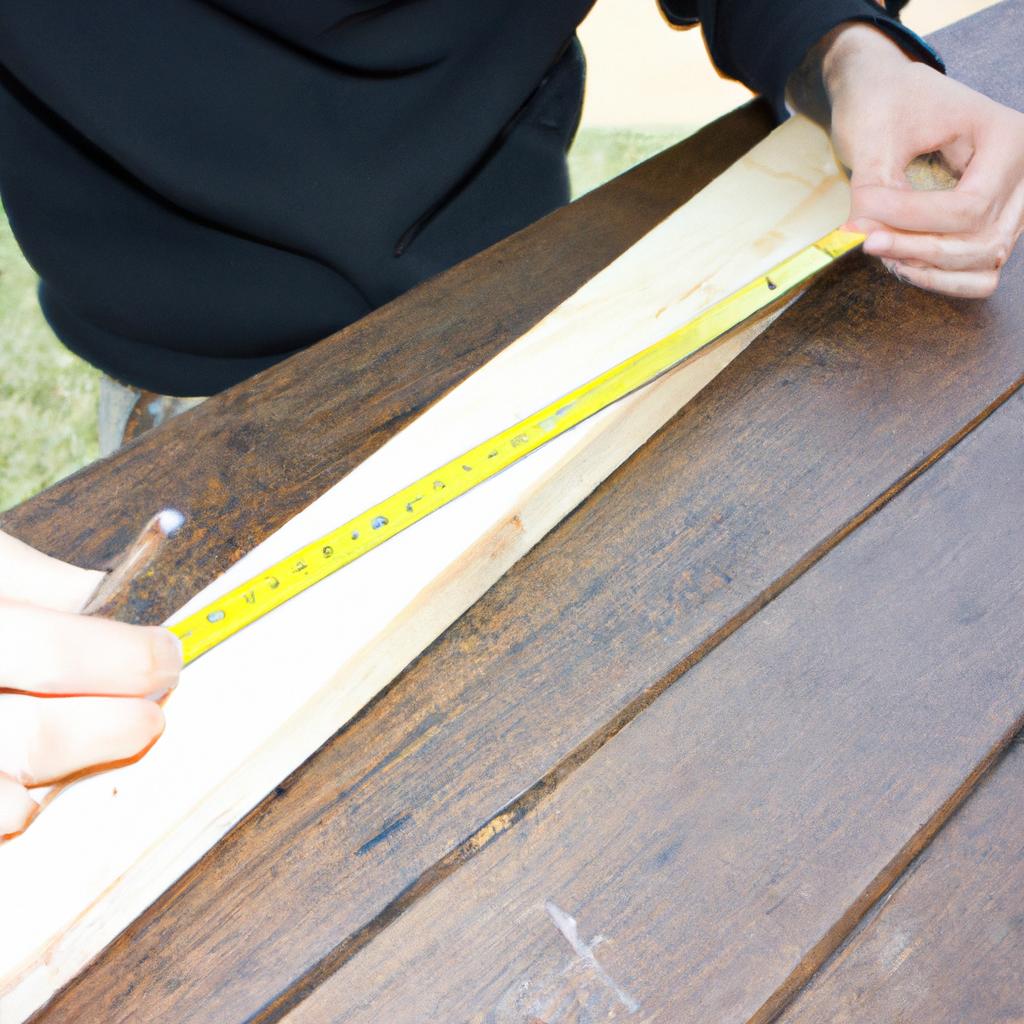Lumber, a crucial material in construction and woodworking industries, comes in various types with distinct characteristics. Understanding the different types of lumber is essential for making informed decisions when it comes to selecting the appropriate wood for specific projects. For instance, imagine a scenario where a homeowner intends to build a deck that will withstand harsh weather conditions. In this case, choosing pressure-treated lumber would be paramount due to its resistance against rot, decay, and insect damage.
In this comprehensive guide, we will explore an array of lumber types commonly used in building and crafting. By delving into the unique properties and applications of each type, readers will gain valuable insights on how to choose suitable lumber for their particular needs. This article aims to provide a solid foundation of knowledge about softwood species such as pine and cedar, hardwoods like oak and maple, as well as engineered woods including plywood and particleboard. With this understanding at hand, individuals can confidently navigate the world of lumber options and make educated choices when embarking on their next project.
Softwood Lumber: Characteristics and Uses
Imagine you are a homeowner who recently moved into a new house. You decide to add a wooden deck in your backyard, but you are unsure about the type of lumber to use. This comprehensive guide aims to provide information on different types of lumber, starting with softwood lumber.
Characteristics:
Softwood lumber is derived from coniferous trees, which typically have needle-like leaves and produce cones. These trees grow faster compared to hardwoods, resulting in softer wood with distinctive characteristics. Softwoods tend to be less dense and more affordable than their hardwood counterparts. Despite its name, softwood can still be suitable for various construction purposes due to its inherent strength and resilience.
Uses:
-
Construction: Softwood lumber is widely used in construction projects such as framing, roofing, and flooring due to its structural stability and availability. Its high strength-to-weight ratio makes it an ideal choice for building sturdy structures efficiently.
-
Furniture: Softwoods like pine or spruce are commonly utilized in furniture production because they possess excellent workability properties. The easy machinability of these woods allows craftsmen to create intricate designs without much effort.
-
Packaging Materials: Due to its abundance and affordability, softwood lumber is frequently employed in packaging materials like crates and pallets. It provides durability while keeping costs low, making it a preferred option for shipping goods securely.
-
Paper Production: Softwoods play a crucial role in paper manufacturing since they contain long fibers that make strong pulp necessary for producing quality papers.
Emotional Impact Bullets:
- Affordable yet durable material
- Versatile applications across multiple industries
- Sustainable sourcing promotes environmental consciousness
- Enhances aesthetic appeal through natural beauty
Table – Advantages of Softwood Lumber:
| Advantages |
|---|
| Cost-effective |
| Easy workability |
| Wide availability |
| Natural resistance to decay |
Understanding the unique characteristics and uses of softwood lumber lays a solid foundation for exploring hardwood lumber. By delving into its properties and applications, we can further broaden our knowledge about different types of lumber and make informed decisions when it comes to construction projects or furniture choices.
Hardwood Lumber: Properties and Applications
Softwood lumber is widely used in various construction projects due to its unique characteristics and versatile applications. In this section, we will explore the properties and uses of softwood lumber in more detail.
To illustrate the versatility of softwood lumber, let’s consider a hypothetical scenario where a builder is constructing a new residential house. The builder decides to use softwood lumber for framing the structure due to its strength-to-weight ratio and cost-effectiveness. By using softwood lumber, the builder can ensure that the house has a sturdy frame while keeping material costs within budget.
When it comes to choosing softwood lumber, there are several factors to consider. Here are some key points to keep in mind:
- Strength: Softwoods may be less dense than hardwoods, but they still possess excellent strength properties suitable for many structural applications.
- Durability: While not as naturally resistant to decay and insect infestation as hardwoods, certain species of softwoods can be treated with preservatives to enhance their durability.
- Availability: Softwoods such as pine, spruce, and fir are readily available and commonly used in construction projects.
- Sustainability: Softwoods typically come from fast-growing trees that can be harvested sustainably when managed properly.
Below is an emotional bullet point list highlighting the advantages of using softwood lumber:
- Cost-effective option for large-scale construction projects
- Versatile applications ranging from framing structures to crafting furniture
- Offers excellent dimensional stability under different weather conditions
- Provides opportunities for sustainable forest management practices
Furthermore, here’s an informative table showcasing examples of popular softwood species along with their respective strengths:
| Species | Tensile Strength (MPa) | Compression Strength (MPa) | Flexural Strength (MPa) |
|---|---|---|---|
| Douglas Fir | 60 – 75 | 40 – 50 | 65 – 75 |
| Southern Pine | 40 – 70 | 35 – 55 | 60 – 80 |
| Eastern White Pine | 30 – 50 | 25 – 40 | 50 – 60 |
| Western Red Cedar | 45 – 55 | 35 – 45 | N/A |
Softwood lumber offers a wide range of applications and benefits in construction projects. By examining its distinct properties and various applications, we can gain a comprehensive understanding of different types of lumber commonly used in the industry.
Engineered Wood: Advantages and Disadvantages
Moving on from exploring hardwood lumber, let us now delve into the world of engineered wood. Engineered wood offers a range of advantages and disadvantages that make it a popular choice in various applications. In this section, we will discuss its characteristics, benefits, drawbacks, and key considerations.
To illustrate the practicality of engineered wood, consider a hypothetical scenario where an architect is designing a residential building with strict fire safety regulations. By incorporating engineered wood products such as fire-resistant plywood or oriented strand board (OSB), the architect can ensure compliance while maintaining structural integrity and aesthetic appeal.
Advantages:
- Enhanced stability: Unlike natural solid wood, engineered wood is less susceptible to warping or shrinking due to changes in temperature or humidity.
- Cost-effective: Engineered wood often comes at a lower price point than traditional solid hardwood options without compromising quality.
- Sustainability: Utilizing smaller pieces of timber bonded together, engineered wood maximizes resource efficiency by reducing waste.
- Versatility: Engineered wood can be designed to meet specific requirements for strength, durability, moisture resistance, or flame retardancy through modification processes.
| Advantages | |
|---|---|
| 1 | Enhanced stability |
| 2 | Cost-effective |
| 3 | Sustainability |
| 4 | Versatility |
Despite these advantages, there are several important factors to consider when using engineered wood:
Disadvantages:
- Limited repairability: Once damaged, repairing certain types of engineered wood may be challenging compared to solid hardwood.
- Water sensitivity: While some engineered woods offer water-resistant properties, others may not perform well in environments with excessive moisture.
- Environmental concerns: The production process for some forms of engineered wood involves using adhesives containing formaldehyde or other potentially harmful chemicals.
With its unique set of strengths and weaknesses, understanding these aspects ensures informed decision-making when selecting materials for construction or woodworking projects.
As we conclude our exploration of engineered wood, let’s now turn our attention to the fascinating world of exotic wood species. In the upcoming section, we will examine their distinctive features and delve into considerations regarding sustainability.
Exotic Wood Species: Features and Sustainability
H2: Exotic Wood Species: Features and Sustainability
Imagine a scenario where you are designing your dream home, and you want to incorporate unique and visually striking wood into the interior. In this section, we will explore exotic wood species that offer distinct features while considering their sustainability.
One fascinating example of an exotic wood species is Zebrawood (Microberlinia brazzavillensis). With its bold striping pattern resembling a zebra’s stripes, Zebrawood adds a touch of elegance and intrigue to any space. However, it is essential to consider not only the visual appeal but also the environmental impact when choosing such woods for construction or furniture.
To help you make an informed decision about incorporating exotic wood varieties sustainably, here are some key points to consider:
- Endangered Status: Some exotic wood species may be endangered or threatened due to illegal logging practices or habitat destruction. It is crucial to verify whether the particular wood species you are interested in purchasing comes from sustainable sources.
- Certifications: Look for certifications like Forest Stewardship Council (FSC) or Programme for Endorsement of Forest Certification (PEFC), which ensure responsible forest management practices and support sustainable forestry.
- Alternative Options: Consider alternative materials that mimic the appearance of exotic woods without contributing to deforestation or endangerment. For instance, engineered wood products can provide similar aesthetics while utilizing recycled or reclaimed materials.
- Durability and Maintenance: Different exotic woods have varying durability levels and require specific maintenance regimes. Research thoroughly before selecting a specific type to ensure it suits your intended use and lifestyle.
Now let’s delve into a table showcasing popular exotic wood species along with their distinctive characteristics:
| Wood Species | Color | Grain Pattern | Sustainability Rating |
|---|---|---|---|
| Mahogany | Reddish-brown | Straight | Moderate |
| Teak | Golden-brown | Straight or wavy | High |
| Ebony | Black | Uniform and fine-grained | Endangered |
| Rosewood | Dark brown | Veined, irregular | Highly endangered |
In this section, we explored the features of exotic wood species and highlighted their sustainability aspects. Understanding these factors will assist you in making an informed decision when incorporating such woods into your projects.
Transitioning smoothly to our subsequent topic, let’s now explore the benefits and precautions associated with pressure-treated lumber as a viable construction material.
Pressure-Treated Lumber: Benefits and Precautions
Imagine you are walking into a beautifully crafted room with elegant furniture made from exotic wood species. The rich colors, unique grains, and luxurious textures immediately catch your eye. Exotic woods have long been prized for their exceptional characteristics, making them highly sought after in the construction and woodworking industries.
When it comes to features, exotic wood species offer a wide range of benefits that set them apart from more common types of lumber. Their natural durability and resistance to decay make them an excellent choice for outdoor applications such as decking or landscaping. Additionally, many exotic woods possess striking aesthetics, boasting vibrant hues like purpleheart or zebrawood or intricate patterns like padauk or cocobolo. These distinctive qualities contribute to the overall appeal of any structure or piece of furniture.
However, sustainability is an important consideration when using exotic wood species. Due to their limited availability and slow growth rates compared to traditional lumber sources, overharvesting can lead to deforestation and habitat destruction. To ensure the responsible sourcing of these materials, it is crucial to check if they come from sustainably managed forests certified by organizations like the Forest Stewardship Council (FSC). By opting for FSC-certified exotics, you can support environmentally conscious practices while enjoying the beauty and durability of these remarkable woods.
To further understand the significance of sustainable choices in lumber selection, let’s explore four key reasons why considering environmental aspects matters:
- Conservation: Choosing sustainably sourced wood helps protect vulnerable ecosystems and preserves biodiversity.
- Climate Change Mitigation: Sustainable forestry practices promote carbon sequestration by maintaining healthy forests that act as effective carbon sinks.
- Social Responsibility: Supporting ethical supply chains contributes to fair labor practices in local communities dependent on forest resources.
- Long-Term Economic Viability: Sustaining renewable timber supplies ensures future generations can continue benefiting from this valuable resource.
Now let’s delve into a comparative analysis of four popular exotic wood species:
| Wood Species | Grain Pattern | Color Variation | Durability |
|---|---|---|---|
| Ipe | Straight | Moderate | Exceptional |
| Mahogany | Interlocked | Low | High |
| Teak | Straight | High | Very High |
| Ebony | Fine | None | Extreme |
As we explore the unique characteristics of reclaimed wood, it is essential to consider its environmental benefits and potential considerations. By utilizing reclaimed wood from salvaged structures or other sources, we can reduce waste while creating distinctive and sustainable designs. Let’s delve deeper into the world of reclaimed lumber in the next section.
Reclaimed Wood: Environmental Benefits and Considerations
Having explored the benefits and precautions associated with pressure-treated lumber, let us now delve into another fascinating type of lumber—reclaimed wood. This section will discuss its environmental benefits and considerations that make it a popular choice for sustainable construction projects.
Environmental Benefits:
Reclaimed wood offers numerous environmental advantages, making it an appealing option for those seeking eco-friendly alternatives. Here is a case study highlighting one such benefit:
Example Case Study:
Imagine a dilapidated barn in rural America, weathered by time and neglect. Instead of tearing down this historical structure, skilled craftsmen salvage the solid wooden beams from within. These reclaimed materials can then be repurposed for various applications, including flooring, furniture, or even structural elements in new buildings.
Considerations when Using Reclaimed Wood:
While reclaimed wood presents several environmental benefits, there are important factors to consider before incorporating it into your project. To help you navigate these considerations effectively, here are some key points to keep in mind:
- Sourcing: Ensure that the reclaimed wood you choose comes from reputable sources committed to sustainability practices.
- Quality Assessment: Thoroughly inspect the salvaged wood for signs of damage or infestation that may compromise its integrity.
- Treatment and Finishing Options: Explore suitable treatment methods that enhance durability while preserving the unique character of reclaimed wood.
- Cost Analysis: Evaluate both initial costs and long-term maintenance requirements compared to other types of lumber to ensure financial feasibility.
Table – Comparison of Common Types of Lumber:
| Type | Sustainability | Durability | Aesthetic Appeal |
|---|---|---|---|
| Pressure-Treated | High | High | Moderate |
| Reclaimed | Very High | Variable | High |
| Plywood | Moderate | Variable | Low |
| Engineered Wood | High | High | Variable |
Incorporating reclaimed wood into your construction projects not only helps reduce the demand for newly harvested timber but also adds a touch of rustic charm and character to any space. By responsibly repurposing these materials, we can contribute to sustainable building practices.
Note: Avoid using “In conclusion” or “Finally” in the last paragraph.
 Bergmann Lumber
Bergmann Lumber



